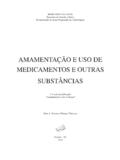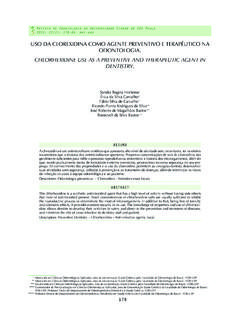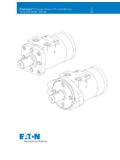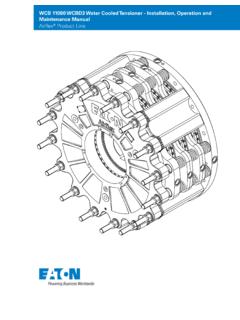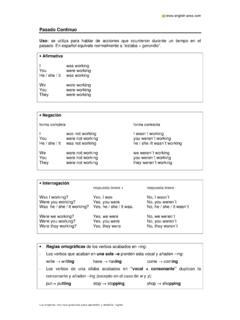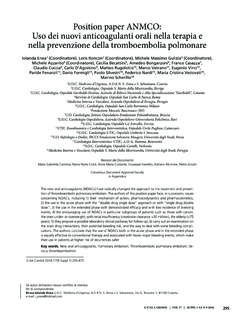Transcription of Code of Conduct - Food and Agriculture Organization
1 The international code of Conduct on Pesticide Management The international code of Conduct on Pesticide Management World Health Organization Food and Agriculture Organization of the United Nations Rome, 2014. The designations employed and the presentation of material in this publication do not imply the expression of any opinion whatsoever on the part of the Food and Agriculture Organization of the United Nations (FAO) or of the World Health Organization (WHO) concerning the legal status of any country, territory, city or area or of its authorities, or concerning the delimitation of its frontiers or boundaries. Dotted lines on maps represent approximate border lines for which there may not yet be full agreement. The mention of specific companies or products of manufacturers, whether or not these have been patented, does not imply that these are or have been endorsed or recommended by FAO or WHO in preference to others of a similar nature that are not mentioned.
2 Errors and omissions excepted, the names of proprietary products are distinguished by initial capital letters. All reasonable precautions have been taken by FAO. and WHO to verify the information contained in this publication. However, the published material is being distributed without warranty of any kind, either expressed or implied. The responsibility for the interpretation and use of the material lies with the reader. In no event shall FAO and WHO be liable for damages arising from its use. The views expressed herein are those of the authors and do not necessarily represent those of FAO or WHO. ISBN 978-92-5-108548-6 (print). E-ISBN 978-92-5-108549-3 (PDF). FAO and WHO, 2014. FAO and WHO encourage the use, reproduction and dissemination of material in this information product.
3 Except where otherwise indicated, material may be copied, downloaded and printed for private study, research and teaching purposes, provided that appropriate acknowledgement of FAO and WHO as the source and copyright holder is given and that FAO and WHO's endorsement of users' views, products or services is not implied in any way. All requests for translation and adaptation rights, and for resale and other commercial use rights should be made via or addressed to FAO information products are available on the FAO website ( publications) and can be purchased through Contents Foreword by the FAO Director-General v Jos Graziano da Silva Foreword by the WHO Director-General vii Margaret Chan Article 1 Objectives of the code 1 Article 10 Labelling, packaging, 24. storage and disposal Article 2 Terms and definitions 3.
4 Article 11 Advertising 26. Article 3 Pesticide management 8. Article 12 Monitoring and Observance 28. Article 4 Testing of pesticides 11 of the code Article 5 Reducing health and 13 Annex 1 international instruments 31. environmental risks in the field of chemical management, environmental Article 6 Regulatory and technical 16 and health protection, requirements sustainable development and international trade, relevant Article 7 Availability and use 19 to the code Article 8 Distribution and trade 20 References 33. Article 9 Information exchange 22 Notes 39. iii Foreword by the FAO Director-General Jos Graziano da Silva This is the fourth version of the Interna- ing and enhancing the natural resources tional code of Conduct on Pesticide Man- on which that production depends. agement that FAO's governing bodies Healthy ecosystems produce more, pre- have approved since 1985.
5 It provides a vent or maintain pests and diseases at framework that guides government reg- acceptable levels and are more resilient ulators, the private sector, civil society to shocks. The new strategic framework and other stakeholders on best practice for FAO has been reoriented to support in managing pesticides throughout their sustainable agricultural production as lifecycle. Its overall structure remains un- one of its strategic objectives. This new changed and covers every aspect of pes- code is an integral component of this ob- ticide management from production to jective. In the area of pest and disease disposal. management this means using Inte- grated Pest Management (IPM), which This version, approved by the 38th FAO has successfully reduced pesticide use Conference in June 2013, incorporates and improved yields, food quality and in- public health pesticides and vector con- comes for millions of farmers.
6 Trol to broaden the scope of the code of Conduct beyond agricultural pesticides. It Providing farmers with access to local gives greater attention to health and en- supplies of well adapted and good quality vironmental aspects of pesticides, up- seeds and planting material helps to pre- dates a number of definitions and terms vent the spread of pests and diseases. and aligns guidance in several technical Protecting soils and attending to nutrient areas with developments in international and water availability to crops produces chemicals management. healthier plants that are more resilient to pest and disease attacks. Such holistic The new code comes at a time when approaches, as embodied in the FAO. greater attention is being focused on in- publication Save and Grow1, help to re- creasing food production while conserv- duce reliance on pesticides and other ex- Foreword by the FAO Director-General Jos Graziano da Silva v ternal inputs with ensuing economic, Pesticides are an important group of health and environmental benefits for chemicals that need careful manage- farmers and consumers.
7 Ment. I encourage all those who have dealings with pest management and The international code of Conduct on pesticides to use this document as a Pesticide Management is a voluntary guiding reference in designing their poli- framework that has been endorsed by cies, legislative texts and technical ap- the FAO Members, and supported by key proaches. Our partnership with WHO and pesticide industry associations and civil UNEP and our close collaboration with society organizations. It complements the private sector and civil society further legally binding instruments such as the strengthen the relevance and broad en- Rotterdam Convention on the Prior In- dorsement of work in this area. formed Consent Procedure for Certain Haz- ardous Chemicals and Pesticides in I hope that through effective implemen- international Trade, the Stockholm Conven- tation of this new international code of tion on Persistent Organic Pollutants and Conduct on Pesticide Management we can the Basel Convention on the Control of achieve significant reduction of risks to Transboundary Movements of Hazardous health and the environment from pesti- Wastes and their Disposal, and voluntary cides, while improving the productivity, mechanisms such as the Strategic Ap- sustainability and livelihoods of farmers proach to international Chemicals Manage- everywhere.
8 Ment (SAICM). Jos Graziano da Silva Director-General of the Food and Agriculture 1. Save and Grow, FAO, 2011 Organization of the United Nations The international code of Conduct vi on Pesticide Management Foreword by the WHO Director-General Margaret Chan The 134th WHO Executive Board has approved by the 38th FAO Conference in taken note of the international code of June 2013, was developed through the Conduct on Pesticide Management. The FAO/WHO joint collaboration on pesti- code of Conduct provides voluntary stan- cide management, and incorporates pub- dards of Conduct for all entities engaged lic health pesticides and vector control to in or associated with the management of broaden its scope beyond agricultural pesticides throughout their life-cycle, pesticides. Of relevance to public health, from production to disposal.
9 The code now focuses on risk reduction The main objective of the code of Con- by calling on countries to identify and, if duct is to maximize the benefits of pes- necessary, remove from use, highly haz- ticides to effectively control pests in ardous pesticides; gives attention to vul- public health and Agriculture , while pro- nerable groups such as children, women tecting human and animal health and the and people affected by HIV/AIDS, em- environment from their harmful effects. phasizes minimizing the use of pesti- cides, and strongly recommends the use The code of Conduct is designed for use of integrated vector management for within national legislation. It describes control of vector-borne diseases. the shared responsibility of many sec- tors; addresses the need for a coopera- The code of Conduct will serve as a guid- tive effort; recognizes the need for ing framework to strengthen the capacity capacity-strengthening for its implemen- of developing Member States to regulate, tation; and describes the standards of evaluate and enforce effective control Conduct for pesticide management, com- over pesticides, including those used in plementing the legally binding instru- public health, that are traded and used in ments on chemicals management.
10 Their territories. Originally developed by FAO in 1985, the WHO urges countries and other stake- current version of the code of Conduct , holders to collaborate and exchange in- Foreword by the WHO Director-General Margaret Chan vii formation and experiences to overcome other United Nations partners, the pri- resource constraints and to build vate sector and civil society to raise needed capacity. FAO and WHO, as the awareness and build capacity for effec- two partner organizations, will further tive implementation of the code of Con- strengthen efforts to work closely with duct in developing countries. Margaret Chan Director-General of the World Health Organization The international code of Conduct viii on Pesticide Management Article 1. Objectives of the code The objectives of this code are to The code describes the shared re- establish voluntary standards of sponsibility of many sectors of so- Conduct for all public and private ciety to work together so that the entities engaged in or associated benefits to be derived from the with the management of pesti- necessary and acceptable use of cides, particularly where there is pesticides are achieved without inadequate or no national legisla- significant adverse effects on tion to regulate pesticides.










